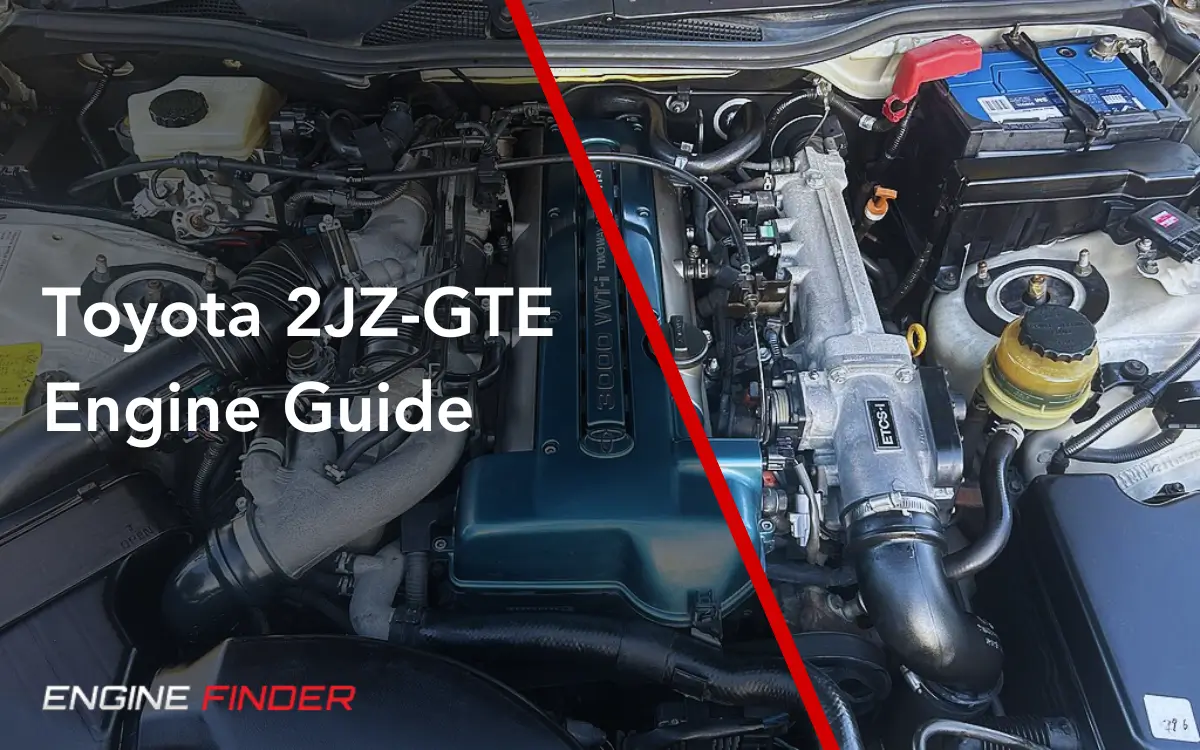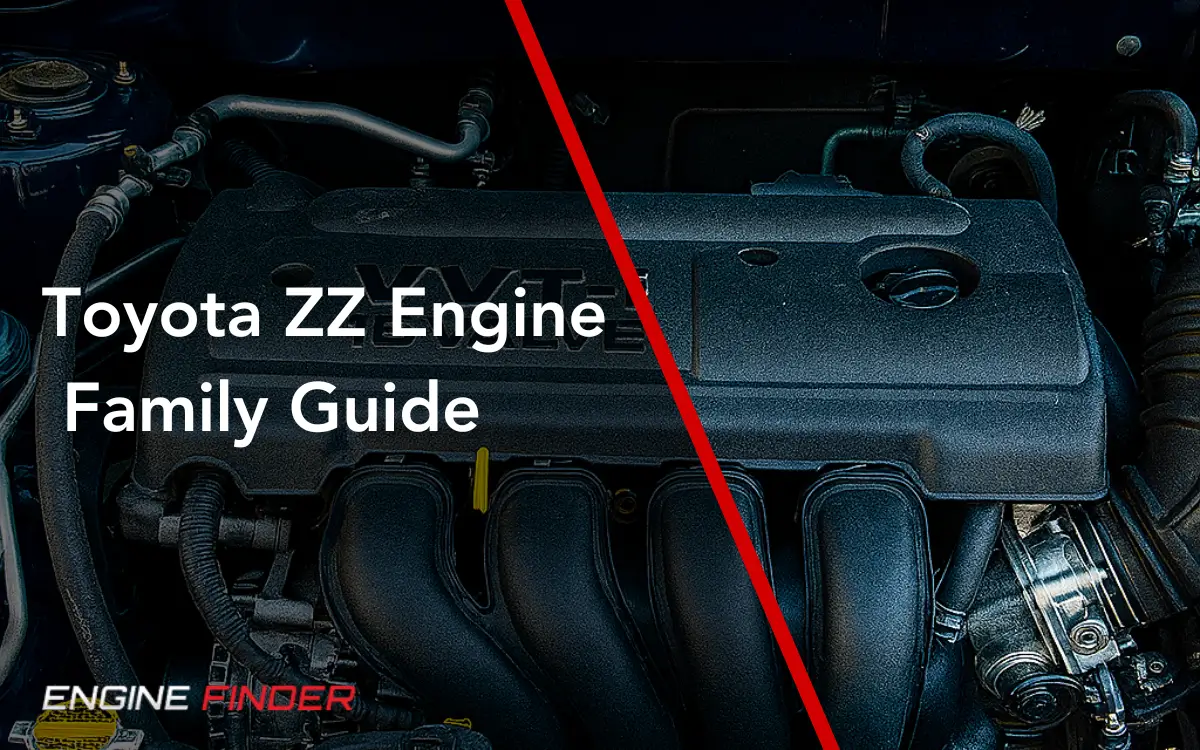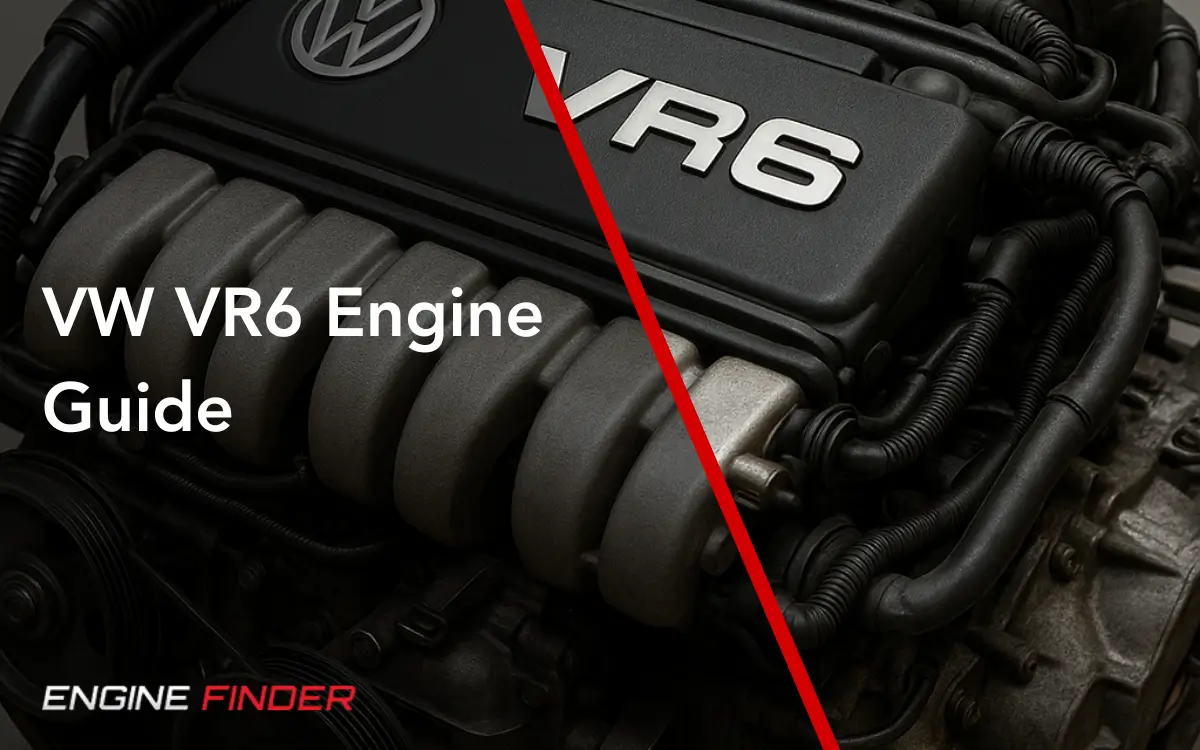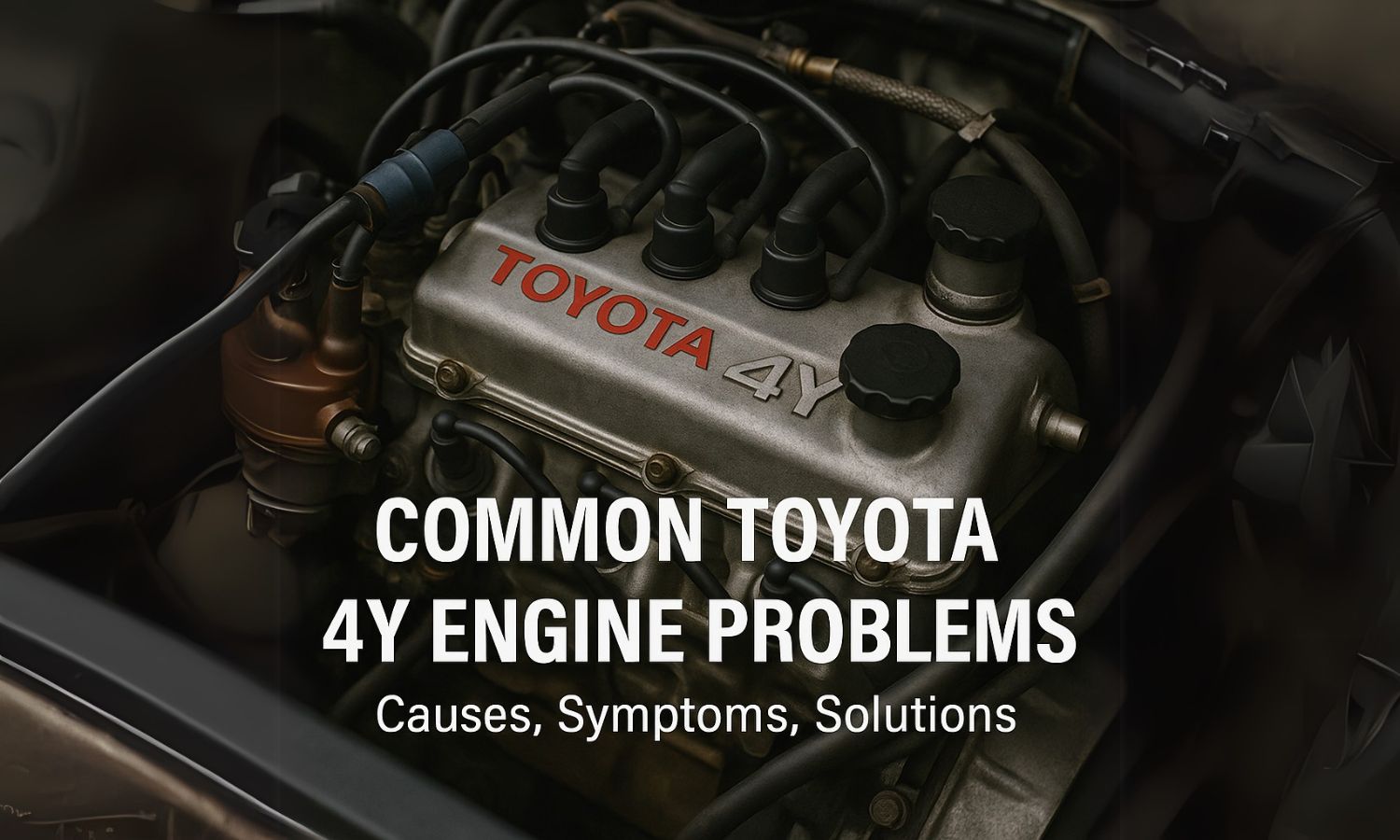
Toyota 2JZ-GTE Engine Guide: The Legendary 3.0L Twin-Turbo Powerplant
Key Takeaways
| Aspect | Details | Significance |
|---|---|---|
| Engine Foundation | 3.0L inline-6, twin-turbo, cast-iron block | Legendary strength and tunability |
| Performance Legacy | 206-243kW factory, 1000hp+ potential | One of the most tunable engines ever |
| Production History | 1991-2002, Supra and Aristo applications | 11 years of refined engineering |
| Tuning Potential | Stock internals handle 600hp reliably | Ultimate enthusiast platform |
| Modern Relevance | Still highly sought after today | Timeless performance icon |
The Toyota 2JZ-GTE stands as one of the most revered engines in automotive history, earning legendary status among enthusiasts worldwide. This 3.0-liter twin-turbocharged inline-six powerplant, produced from 1991 to 2002, powered iconic vehicles like the Toyota Supra and Aristo, establishing a reputation for incredible strength, reliability, and tuning potential that remains unmatched today.
Understanding the Code: Wondering what “2JZ-GTE” actually means? The “2” indicates second-generation JZ family, “JZ” represents Toyota’s performance inline-6 family, and “GTE” signifies twin-cam, turbo, and electronic fuel injection. Learn more about Toyota’s engine naming system explained to decode any Toyota engine code.
While many performance engines of the 1990s have faded into obscurity, the 2JZ-GTE continues to be the gold standard for high-performance builds, commanding premium prices and inspiring countless enthusiasts to pursue Toyota engines for sale for their projects.
What Makes the 2JZ-GTE Great?
Toyota 2JZ - What makes it GREAT? ICONIC ENGINES #14
Toyota 2JZ-GTE Engine Specifications
2JZ-GTE Technical Specifications
Interactive technical overview of the legendary powerplant
Production Timeline
| Specification | Details |
|---|---|
| Engine Code | 2JZ-GTE |
| Displacement | 3.0L (2,997cc) |
| Configuration | Inline-6, DOHC |
| Block Material | Cast Iron |
| Head Material | Aluminum |
| Bore x Stroke | 86.0mm x 86.0mm (square) |
| Compression Ratio | 8.5:1 |
| Valvetrain | DOHC, 24 valves (4 per cylinder) |
| Fuel System | Sequential Multi-Port Injection |
| Turbocharging | Sequential Twin-Turbo |
| JDM Specifications | |
| Power Output | 206kW (276hp) @ 5,600 rpm |
| Torque | 432Nm (318 ft-lb) @ 3,600 rpm |
| Turbochargers | CT20 (ceramic) |
| Fuel Injectors | 440cc |
| USDM Specifications | |
| Power Output | 239kW (320hp) @ 5,600 rpm |
| Torque | 441Nm (325 ft-lb) @ 3,600 rpm |
| Turbochargers | CT12B (steel) |
| Fuel Injectors | 550cc |
| VVT-i Version (1997+) | |
| Torque | 451Nm (332 ft-lb) @ 3,600 rpm |
| Production Years | 1991-2002 |
| Weight | 230kg (507 lbs) |
History and Development
Origins and Design Philosophy
The 2JZ-GTE was born from Toyota’s ambition to create a world-class performance engine that could compete with the best Europe and America had to offer. Development began in the late 1980s as Toyota recognized the need for a successor to the aging 7M-GTE engine, which had served in the previous-generation Supra but suffered from reliability issues.
Toyota’s engineering team set ambitious goals: create an engine that would be not only powerful but also exceptionally robust, capable of handling significant power increases while maintaining the reliability Toyota was known for. The result was an engine that would become legendary in the automotive world.
Two Distinct Generations
First Generation (1991-1996) The original 2JZ-GTE debuted in the 1991 Toyota Aristo, featuring sequential twin-turbochargers and producing a conservatively rated 206kW. This was followed by its most famous application in the 1993 Toyota Supra Turbo, where it gained worldwide recognition.
Second Generation (1997-2002) The introduction of VVT-i (Variable Valve Timing-intelligent) marked the second generation, bringing improved torque delivery and enhanced drivability while maintaining the same power output. Electronic throttle control was also added, providing more precise engine management.
Technical Excellence and Engineering
Engine Block and Foundation
The 2JZ-GTE’s legendary strength begins with its cast-iron engine block, featuring a semi-closed deck design that provides exceptional rigidity. The seven-bearing crankshaft support system ensures stability even under extreme loads, while the fully counterweighted forged crankshaft can handle massive power increases.
Key Structural Features:
- Cast-iron construction for maximum strength
- Semi-closed deck design for rigidity
- Seven-bearing crankshaft support
- Oil spray nozzles for piston cooling
- Robust connecting rods and pistons
Advanced Head Design
The aluminum cylinder head features a sophisticated DOHC 24-valve design with dual belt-driven camshafts. The intake and exhaust ports are carefully designed for optimal flow characteristics, while the valve angle is optimized for performance applications.
Cylinder Head Highlights:
- Aluminum construction for weight savings
- DOHC with 24 valves (4 per cylinder)
- Optimized port design for flow
- VVT-i on intake cam (1997+ models)
- Electronic throttle control (later models)
Sequential Twin-Turbo System
Perhaps the most distinctive feature of the 2JZ-GTE is its sequential twin-turbocharger system. This sophisticated setup uses two turbochargers in sequence, with the primary turbo handling low-RPM boost delivery and the secondary turbo coming online at higher RPMs to minimize lag while maximizing power.
Turbo System Benefits:
- Reduced turbo lag across RPM range
- Broad, flat torque curve
- Excellent drivability
- Complex but effective design
Engineering Excellence
The 2JZ-GTE’s square bore and stroke dimensions (86x86mm) create an ideal balance between high-RPM capability and torque production, contributing to its legendary tunability and broad powerband.
Performance Characteristics
Factory Performance
Even in factory form, the 2JZ-GTE delivered impressive performance that rivaled much more expensive European alternatives. The conservative power ratings were typical of Japanese manufacturers during the “gentlemen’s agreement” era, but real-world dyno testing often revealed higher actual outputs.
Power Delivery Characteristics:
- Broad, usable powerband
- Strong low-end torque delivery
- Linear power increase
- Excellent throttle response
- Smooth operation throughout RPM range
International Market Differences
Interestingly, the 2JZ-GTE received different specifications depending on the market. Japanese Domestic Market (JDM) versions used ceramic-wheeled CT20 turbochargers and smaller injectors, while North American and European markets received steel-wheeled CT12B turbos and larger fuel injectors, resulting in higher power outputs.
JDM vs USDM Comparison
Explore the fascinating differences between Japanese and North American market specifications
JDM Market
Japanese Domestic Market
Conservative power ratings
USDM Market
US & European Market
Higher performance specs
Power Output
276 hp @ 5,600 rpm
320 hp @ 5,600 rpm
Torque Output
318 lb-ft @ 3,600 rpm
325 lb-ft @ 3,600 rpm
Turbochargers
Ceramic turbine wheels
Steel turbine wheels
Fuel Injectors
High-impedance type
Low-impedance type
Airflow Metering
Manifold Absolute Pressure
Mass Air Flow sensor
Cam Duration (Intake)
Conservative tuning
More aggressive profile
Market Comparison Summary
Key Market Differences
🇯🇵 JDM Market
🇺🇸 USDM Market
*Gentlemen's Agreement (1989-2005): Japanese automakers voluntarily agreed to limit advertised power to 280 PS (206kW), even though actual engine output was often higher. This agreement only applied to the Japanese domestic market, allowing USDM versions to advertise their true power figures.
Market Variations:
- JDM: 206kW/432Nm, ceramic turbos, MAP sensor
- USDM/EDM: 239kW/441Nm, steel turbos, MAF sensor
- VVT-i: 206-239kW/451Nm depending on market
Real-World Performance
In practice, the 2JZ-GTE delivered performance that made it competitive with engines from prestigious manufacturers. The combination of strong low-end torque and high-RPM capability made it equally at home on the street or track, contributing to its enduring popularity among performance enthusiasts.
Power & Torque Curves
Interactive dyno chart showing 2JZ-GTE performance characteristics
*JDM Gentlemen's Agreement: Japanese automakers voluntarily limited advertised power to 280 PS (206kW) from 1989-2005, though actual output was often higher. USDM versions were not subject to this agreement.
Vehicle Applications and Legacy Models
Primary Applications
The 2JZ-GTE found its way into several iconic Toyota vehicles, each showcasing different aspects of the engine’s capabilities:
Toyota Supra (JZA80) - 1993-2002 The most famous application of the 2JZ-GTE, the fourth-generation Supra became an instant icon. Available with both 6-speed manual and 4-speed automatic transmissions, the Supra Turbo demonstrated the engine’s full potential and became the poster child for Japanese performance cars.
Toyota Aristo (JZS147/JZS161) - 1991-2002 The luxury sedan that first introduced the 2JZ-GTE to the world. The Aristo showcased the engine’s refinement and smooth operation in a more comfort-oriented application, proving its versatility beyond pure performance applications.
Regional Availability
While the 2JZ-GTE was primarily available in Japanese and select international markets, its reputation has made it a highly sought-after engine worldwide. In South Africa, these engines command premium prices, often exceeding the cost of modern alternatives due to their legendary status and proven capabilities.
Applications by Market:
- Japan: Supra, Aristo (all variants)
- North America: Supra Turbo only
- Europe: Limited Supra availability
- Australia: Grey import Supra and Aristo models
Collector’s Market
Original 2JZ-GTE powered vehicles have become highly collectible, with pristine examples commanding six-figure sums. This has made the standalone engine an attractive alternative for enthusiasts seeking to experience this legendary powerplant.
Tuning and Modification Potential
Stock Engine Capabilities
One of the most remarkable aspects of the 2JZ-GTE is its ability to handle significant power increases with minimal modifications. The robust construction allows the stock bottom end to safely handle 600 horsepower with proper tuning, while the closed-deck block design provides the strength needed for extreme builds.
Stock Engine Limits:
- Conservative: 450-500hp (daily driver reliable)
- Aggressive: 600hp (weekend warrior)
- Maximum: 800hp (with upgraded main bearing caps)
Popular Modification Paths
The 2JZ-GTE’s modification potential is virtually limitless, with well-documented upgrade paths for every performance level:
Stage 1 Modifications (400-500hp):
- Exhaust system upgrade
- Cold air intake
- Boost controller
- ECU tune
- Cost: R25,000-R40,000
Stage 2 Modifications (500-700hp):
- Larger turbochargers
- Upgraded fuel system
- Intercooler upgrade
- Internal engine refresh
- Cost: R60,000-R120,000
Stage 3+ Modifications (700hp+):
- Built bottom end
- Custom turbo system
- Race fuel system
- Professional tuning
- Cost: R150,000-R300,000+
Aftermarket Support
The 2JZ-GTE enjoys unparalleled aftermarket support, with virtually every component available in upgraded form. This extensive ecosystem makes building a high-performance 2JZ more accessible than many modern alternatives, despite the engine’s age.
Available Upgrades:
- Turbocharger systems (single and twin)
- Engine management systems
- Fuel system components
- Internal engine components
- Cooling system upgrades
Maintenance and Service Requirements
Routine Maintenance
Despite its performance capabilities, the 2JZ-GTE maintains Toyota’s reputation for reliability when properly maintained. Regular service intervals and quality components are key to longevity.
Service Schedule
| Service Type | Interval | Components | Estimated Cost |
|---|---|---|---|
| Oil Changes | 5,000-7,500 km | Oil, filter | R800-R1,200 |
| Timing Belt | 100,000 km | Belt, tensioners, water pump | R8,000-R12,000 |
| Turbo Service | 80,000 km | Seals, bearings, oil lines | R15,000-R25,000 |
| Fuel System | 60,000 km | Filters, pump, injector service | R5,000-R8,000 |
| Cooling System | 80,000 km | Radiator service, hoses, thermostat | R4,000-R7,000 |
Critical Maintenance Items
Oil Quality: Use high-quality 5W-30 or 0W-30 synthetic oil Fuel Quality: Premium unleaded fuel (95+ octane) essential Cooling System: Maintain proper coolant levels and temperature Turbo Care: Allow proper warm-up and cool-down periods Air Filtration: Keep intake system clean for optimal performance
Common Service Items
While generally reliable, certain components require attention:
- Valve stem seals: May require replacement around 150,000 km
- Coil packs: Factory units can fail with age
- Turbo seals: Normal wear item on high-mileage engines
- Fuel injectors: May require cleaning or replacement
Maintenance Critical
The 2JZ-GTE’s legendary reliability depends entirely on proper maintenance. Neglecting service intervals or using poor-quality fluids can quickly destroy even this robust engine.
Modern Relevance and Legacy
Continued Popularity
More than 20 years after production ended, the 2JZ-GTE remains one of the most sought-after engines in the world. Its combination of strength, tunability, and prestige has created a thriving market for both complete engines and restoration projects.
Market Value and Availability
In South Africa, 2JZ-GTE engines command premium prices:
Engine Pricing (2025):
- Running engine: R80,000-R150,000
- Rebuilt engine: R120,000-R200,000
- Race-built engine: R200,000-R400,000+
The high values reflect both the engine’s desirability and increasing scarcity, making it a significant investment for any project.
Influence on Modern Engines
The 2JZ-GTE’s design philosophy has influenced countless modern engines, with manufacturers studying its strength and tunability characteristics. While modern engines may be more efficient, few match the 2JZ’s combination of performance potential and bulletproof reliability.
Alternative Options
For enthusiasts unable to source a 2JZ-GTE, several alternatives offer similar characteristics:
- BMW N54/N55: Modern twin-turbo inline-6 with good tuning potential
- Nissan RB26DETT: Contemporary rival with strong aftermarket support
- Ford Barra: Australian inline-6 turbo with excellent potential
- Toyota 1JZ-GTE: Smaller displacement sibling with similar characteristics
While often more readily available through local suppliers, these alternatives rarely match the 2JZ-GTE’s legendary status and proven track record, making genuine 2JZ engines highly prized among serious enthusiasts.
FAQ
Why is the 2JZ-GTE considered legendary?
The 2JZ-GTE earned its legendary status through an exceptional combination of factors: bulletproof reliability, massive tuning potential (handling 1000+ horsepower with modifications), and iconic applications in vehicles like the Toyota Supra. Its cast-iron block construction and robust internal components make it virtually indestructible when properly maintained.
What’s the difference between JDM and USDM 2JZ-GTE engines?
JDM (Japanese Domestic Market) versions produce 206kW with ceramic-wheeled CT20 turbochargers and use a MAP sensor, while USDM (US Domestic Market) versions produce 239kW with steel-wheeled CT12B turbos and use a MAF sensor. USDM versions also have larger fuel injectors (550cc vs 440cc).
How much power can a stock 2JZ-GTE handle?
A stock 2JZ-GTE can reliably handle 600 horsepower with proper tuning and supporting modifications. For ultimate reliability, most experts recommend staying below 500 horsepower on stock internals for daily driving applications.
Are 2JZ-GTE engines still available new?
Toyota still manufactures some 2JZ components including blocks and heads (VVT-i version only), but complete new engines are not available. The aftermarket has responded with billet blocks and heads for extreme builds, though these cost significantly more than original Toyota components.
What makes the 2JZ-GTE so strong?
The engine’s strength comes from its cast-iron block construction, closed-deck design, seven-bearing crankshaft support, forged crankshaft, and robust internal components. The square bore and stroke dimensions also contribute to its ability to handle high power levels.
Is the 2JZ-GTE suitable for daily driving?
Absolutely. In stock form, the 2JZ-GTE is extremely docile and reliable for daily use, offering smooth operation and good fuel economy when driven conservatively. Even modified versions can be daily-driven if tuned properly with appropriate supporting modifications.
Conclusion
The Toyota 2JZ-GTE stands as a testament to exceptional engineering and timeless design. From its introduction in 1991 to its discontinuation in 2002, this legendary inline-six established benchmarks for strength, reliability, and tuning potential that remain unmatched today.
Whether you’re an enthusiast seeking the ultimate tuning platform, a collector pursuing automotive history, or simply someone who appreciates engineering excellence, the 2JZ-GTE represents the pinnacle of Japanese performance engine development. Its continued relevance and desirability, more than two decades after production ended, speaks to the enduring quality of Toyota’s engineering achievement.
For South African enthusiasts exploring their options, Engine Finder provides access to quality Toyota engines for sale across the country, connecting you with suppliers who understand the value and significance of these legendary powerplants.
The 2JZ-GTE isn’t just an engine—it’s an icon, a legend, and for many enthusiasts, the holy grail of automotive powerplants. In a world of increasingly complex and restrictive modern engines, the 2JZ-GTE remains a beacon of pure, unbridled performance potential.
References and Further Reading
Technical Resources
- Toyota JZ Engine Family Technical Documentation - Comprehensive technical specifications and maintenance data
- HP Academy 2JZ-GTE Engine Guide - Detailed tuning and performance information
- AutoSpeed JZ Engine Family Guide - Complete guide to Toyota JZ-series engines
Performance and Tuning Resources
- Society of Automotive Engineers (SAE) International - Professional technical papers on engine development and performance
- Toyota Technical Information System - Official Toyota service documentation and technical bulletins
Related Articles
Explore more insights on similar topics

Toyota ZZ Engine Family: Complete Guide to the 1ZZ, 2ZZ, 3ZZ & 4ZZ
Comprehensive guide to Toyota's ZZ engine family including the high-revving 2ZZ-GE, reliable 1ZZ-FE, and economical 3ZZ/4ZZ variants. Technical specs, applications, and known issues.

Volkswagen VR6 Engine Guide: The Revolutionary Narrow-Angle Six-Cylinder
Complete guide to Volkswagen's revolutionary VR6 engine. Discover its unique narrow-angle design, technical innovations, and 33-year production legacy that redefined compact performance.

Common Toyota 4Y Engine Problems: Causes, Symptoms, Solutions
Learn about the most common problems with Toyota 4Y engines found in Hilux, HiAce, and Forklifts, with detailed troubleshooting tips and repair costs.
Important Disclaimer
This content is for informational purposes only and is based on research from automotive industry sources. Engine Finder is not a certified automotive repair facility. Always consult with qualified automotive professionals before performing any repairs or maintenance. Improper repairs can result in personal injury, property damage, or vehicle malfunction. We assume no responsibility for actions taken based on this information.
